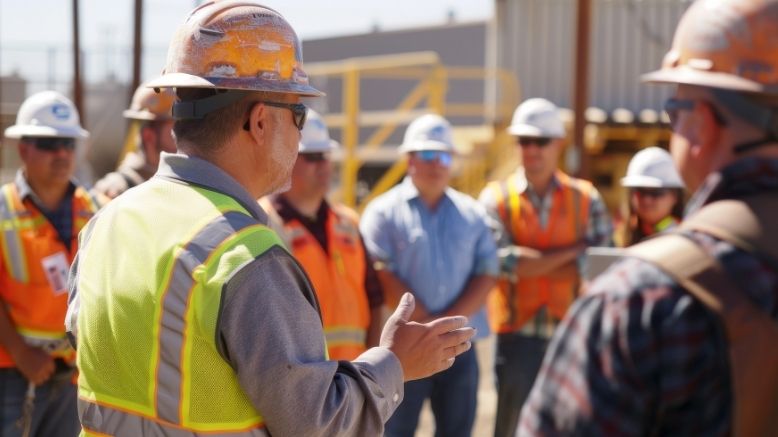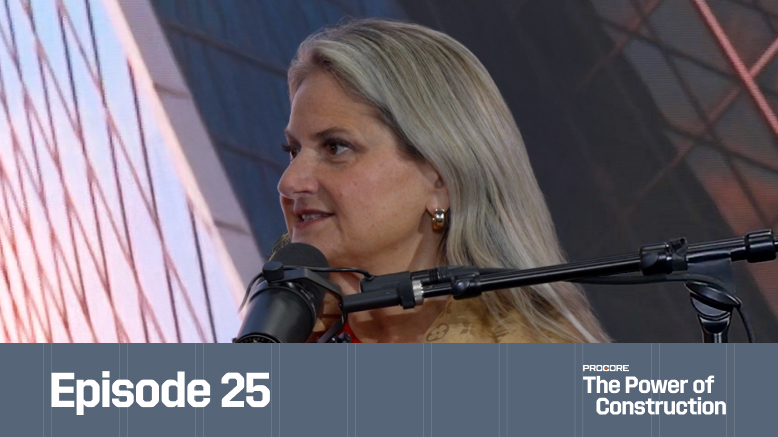— 4 min read
Winning Technology Adoption from the Office to the Field


Last Updated Oct 8, 2025

Steven Beemsterboer
Project Manager
Steven Beemsterboer is a Project Manager and Estimator at Metropolitan Steel Inc., a Chicago-based structural steel erector specializing in bridge construction and structural steel projects. He oversees project planning, scheduling, logistics, and engineering coordination, while also serving as the company’s point person for operational technology—implementing systems that improve communication, efficiency, and data use across field and office teams. Steven’s academic background includes graduate studies in MBA Construction Business Development at the University of Oklahoma and Construction Technology Management at LSU, along with undergraduate studies in physics, theater, and media design at Marymount Manhattan College in New York City. He approaches problem-solving with both technical rigor and creative thinking and is passionate about building strong teams, supporting tradespeople, and helping specialty contractors adopt innovation while staying true to the pride and craftsmanship of the industry.

Diane McCormick
Writer
49 articles
Diane McCormick is a freelance journalist covering construction, packaging, manufacturing, natural gas distribution, and waste oil recycling. A proud resident of Harrisburg, PA, Diane is well-versed in several types of digital and print media. Recognized as one of the premier voices in her region, she was recognized as the Keystone Media Freelance Journalist of the Year in 2022 and again in 2023.
Last Updated Oct 8, 2025

The construction sector is often wrongly labeled as resistant to change. The truth is, crews readily embrace tools that make sense and save time. The challenge lies with innovation leaders.
When leaders master new systems and clearly prove their value, naysayers quickly become champions. This article explores how to get started with the technology adoption process and offers tips for personalizing training to win over users.
Table of contents
5 key tips for choosing and implementing new tech
New technology should never be adopted for its own sake. It must directly support core goals like risk mitigation, efficiency and safe, profitable project delivery. These benefits must be clearly demonstrated to both office and field teams.
Success begins with leaders who immerse themselves in a system's functions well before a rollout, so they can answer questions, remove friction and show real-world value.
Here are 5 key tips leaders should consider when choosing and implementing a tech tool.
1. Pick your battles.
Tech can’t solve every problem at once. The highest ROI, in money and time, comes from targeting the most error-prone or problematic processes.
For example, if submitting timecards involves cumbersome handwritten forms, inefficient submittal processes and manual digital entry, mistakes will be made and time consumed.
2. Find a versatile tool.
Construction management software can be limited to a certain process, such as those timecard submittals, or it can serve as a platform for further growth.
Choosing a versatile, robust system gives the organization’s technological powers room to expand.
3. Master the system.
Don’t drop a new, untested system into the hands of field people, who are sure to find too much frustration and too few answers.
Instead, the initiative lead should keep the system in the office until features and workflow have been thoroughly tested. The leaders who learn how to operate the system build their expertise, project confidence and establish themselves as the go-to resource for questions and problems.
Before you roll anything out, the leader of the initiative has to really know the system. If I don’t believe in it and if I can’t answer the questions that come up, how can I expect the guys in the field to have confidence in it?

Steven Beemsterboer
Project Manager
Metropolitan Steel
4. Conduct pilot testing.
After office-level beta testing is complete, it’s time to slowly spool out the system to the field. Start with a handful of champions, chosen for their collaborative natures and the respect of their peers and teams. When approaching them, frame the situation as an opportunity to help improve the company and resolve the field’s most irksome problems.
5. Welcome a mix of perspectives in leadership.
Technology initiatives benefit when leadership includes different voices. Skepticism isn’t a hurdle. It’s valuable, because it forces the team to think critically and refine the process before rollout. If no one naturally fills the role of a skeptic, challenge yourselves as a company to step back and question assumptions.
You want support but you also want resistance, for healthy debate and collaborative leadership.
Steven Beemsterboer
Project Manager
Metropolitan Steel
Making training stick
In addition to clearly articulating value during a rollout, training practices must demonstrate unwavering support to avoid resistance to adoption. Adoption is successful when training shows patience, proves value and supports the team every step of the way.
Instead of having a room full of people watch presentations or get sent to YouTube videos, try personalizing training. Design toolbox training sessions and deliver them as often as needed, one on one or in small groups. Walk users through every step, demonstrating the advantages over previous processes.
Make it clear to every user that someone is available to answer any and all questions. When calls for help come in, a little contrition from the trainer can help users feel comfortable reaching out.
If the construction industry seems resistant to change, it’s not because they're stubborn. The field is a smart group. They’re resistant because the value of the tool hasn’t been shown clearly enough. When the first electric drill hit the field, no one said, ‘I’ll stick with the hand crank.’ They saw instantly how much faster it made their work.
Steven Beemsterboer
Project Manager
Metropolitan Steel
Collect feedback from the team daily or weekly, whether informally or formally. After a technology has been rolled out individually — without a big announcement — bring the team together for open feedback.
Ask how people feel about the system and what they would change. If the rollout has been sensitive to change management and has proven the leader's 100% mastery of the system, there is a good chance that users will say they love it and want more.
Free AI in Construction Course with Hugh Seaton
Start learning today with industry expert Hugh Seaton and discover how AI can boost efficiency, reduce risk, and transform your projects.

Making change work
“Why change?” is a fair question on any jobsite. The real answer is that change is never about the tool. It’s about building a culture where improvement is constant.
With clear value and strong systems, the hardest part of adoption — the process itself — becomes simpler, and even skeptics can take pride in leading the way forward.
Was this article helpful?
Thank you for your submission.
0%
0%
You voted that this article was . Was this a mistake? If so, change your vote
Scroll less, learn more about construction.
Subscribe to The Blueprint, Procore’s construction newsletter, to get content from industry experts delivered straight to your inbox.
By clicking this button, you agree to our Privacy Notice and Terms of Service.
Thank you!
You’re signed up to receive The Blueprint newsletter from Procore. You can unsubscribe at any time.
Categories:
Written by

Steven Beemsterboer
Project Manager | Metropolitan Steel
Steven Beemsterboer is a Project Manager and Estimator at Metropolitan Steel Inc., a Chicago-based structural steel erector specializing in bridge construction and structural steel projects. He oversees project planning, scheduling, logistics, and engineering coordination, while also serving as the company’s point person for operational technology—implementing systems that improve communication, efficiency, and data use across field and office teams. Steven’s academic background includes graduate studies in MBA Construction Business Development at the University of Oklahoma and Construction Technology Management at LSU, along with undergraduate studies in physics, theater, and media design at Marymount Manhattan College in New York City. He approaches problem-solving with both technical rigor and creative thinking and is passionate about building strong teams, supporting tradespeople, and helping specialty contractors adopt innovation while staying true to the pride and craftsmanship of the industry.
View profile
Diane McCormick
Writer | Procore Technologies
49 articles
Diane McCormick is a freelance journalist covering construction, packaging, manufacturing, natural gas distribution, and waste oil recycling. A proud resident of Harrisburg, PA, Diane is well-versed in several types of digital and print media. Recognized as one of the premier voices in her region, she was recognized as the Keystone Media Freelance Journalist of the Year in 2022 and again in 2023.
View profileExplore more helpful resources

Defending Against Financial & Legal Risks on Megaprojects
The construction industry has seen marked growth in megaprojects. Some experts classify any project over $500 million as a megaproject, while others argue that the build needs to be $1...

Unlocking Project Intelligence: Moving from Raw Data to Actionable Insights
The construction industry faces a wide range of challenges, from ongoing labor shortages to frequent cost overruns. But some the biggest hurdles all stem from unpredictability. The general contractors (GCs)...

Who is accountable for innovation in construction?
Everyone says construction needs to innovate—but no one agrees on who’s actually responsible for making it happen. Is it the owner? The builders? The tech vendor? Or is innovation everyone’s...

Integrated Project Delivery in Practice: A Framework for Collaboration
On construction projects, traditional delivery methods put different stakeholders in their own silos. While the design team feeds drawings and specifications to the general contractor (GC), the GC’s expertise in...
Free Tools
Calculators
Use our calculators to estimate the cost of construction materials for your next project.
Templates
Find a template to help you with your construction project tasks.
Material Price Tracker
Get the latest U.S. retail prices and view historical trends for common building materials.
Glossary
Explore key terms and phrases used in the industry.
